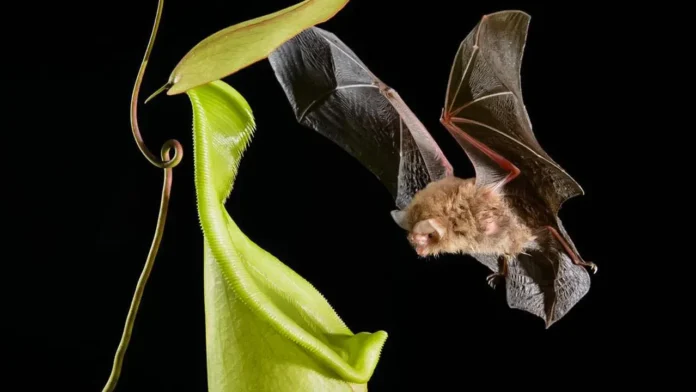“The Mutualism Between Bats and Pitcher Plants” Excerpt
“This week’s paper is in Scientific Reports, lead authored by Michael Schöner at the University of Greifswald in Germany. The research focuses on an extraordinary relationship between the woolly bat, Kerivoula hardwickii, and a pitcher plant, Nepenthes hemsleyana. Pitcher plants are believed to have evolved in areas with low soil nitrogen content. To achieve their necessary nutrients these plants have turned to carnivory. The pitcher part is a liquid trap, usually filled with digestive juices. The pitchers emit odors that attract insects who become trapped in the pitcher where they are digested, providing nutrients for the plant. Nepenthes hemsleyana, however, is different. Rather than emitting attractive odors or containing digestive juices, instead the pitcher of N. hemsleyana is a perfect roost for bats. Woolly bats sleep in the pitcher plant during the day, and poop there, providing nitrogen for the plant. These pitchers have an unusual shape that makes them not only ideal for a sleeping bat, but also easily detected by echolocation. Additionally, the inner wall of the pitcher has a waxy texture that deters egg-laying insects, providing a pest-free home for the bats. This is considered a mutualism, because the bat provides poop to the plant, and the plant provides a roost for the bat.
The mutualism between woolly bats and pitcher plants is likely stabilized by the high quality of the pitcher plants as roosts, and a general preference of bats to use them when they are available. Interestingly, however, it appears that there are individual bats that will use furled leaves as roosts for their entire lifetimes. This willingness to use other roosts could buffer the populations of woolly bats from environmental perturbations that reduce the availability of pitcher plant roosts.”
.
REVIEW
Woolly bats and pitcher plants have a mutualism relationship, however interestingly only one is dependent on the other. The pitcher plant can not survive without the bat, as it is not good at catching insects. The bat can choose to live anywhere. The pitcher plant has to attract the bat and be a better habitat than any other habitat is. This is what is interesting to me; how the pitcher plant developed different features to make the best sleeping spot for the woolly bat to live in. Things like the layer on the inside being resistant to egg laying bugs are what makes it such a good sleeping pod. I find this interesting when compared to human’s interactions with things. This makes me think about how to make a human choose something even if there are other options. What is needed to make my design the design they choose? Collectively, what aspects can attract a large range of different kinds of people as well? Another critical piece is that the bats stay with the pitcher plant, which means it is a sustainable place for bats to use. Sustainability and returnability are both important in creating my design.
REFERENCES
Lee, C. (n.d.). Wooly bat flying toward a pitcher plant.The Common Naturalist. https://commonnaturalist.com/2016/05/13/the-bats-that-live-in-carnivorous-plants/
Jones, P. (2017, October 30). The mutualism between bats and pitcher plants. Jones lab at Bowdoin. http://www.joneslabbowdoin.com/new-paper-friday-1/2017/10/27/the-mutualism-between-bats-and-pitcher-plants




